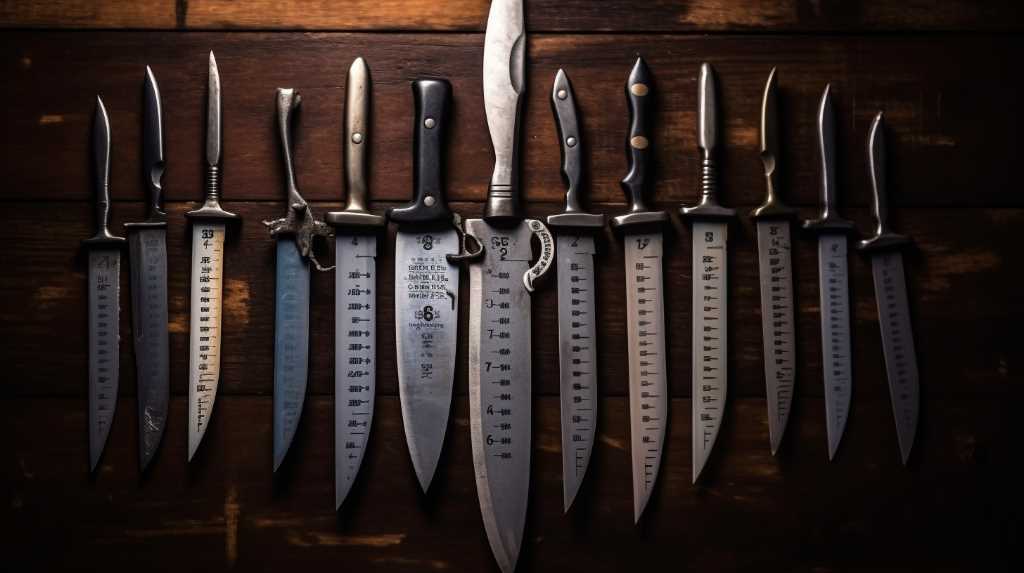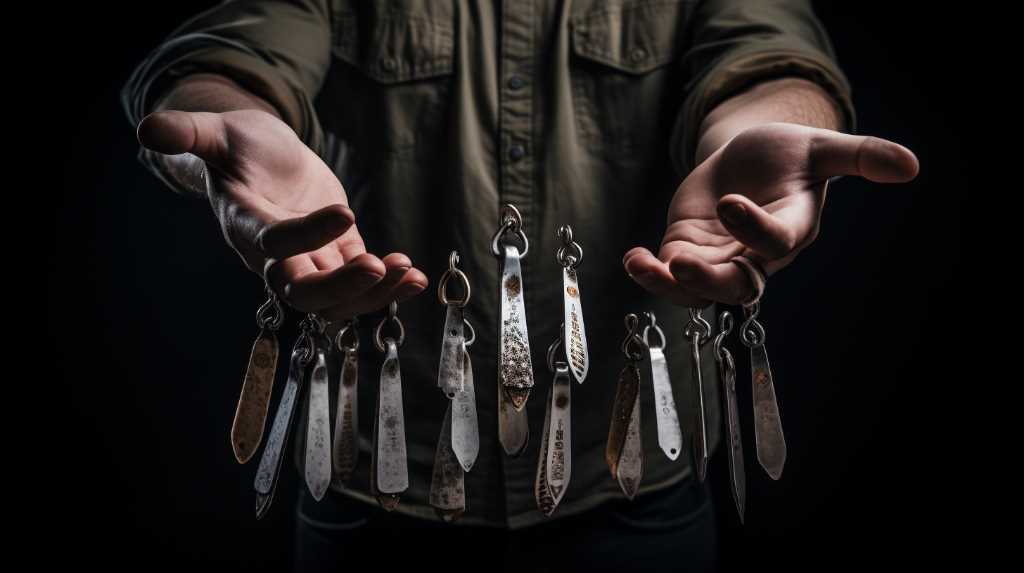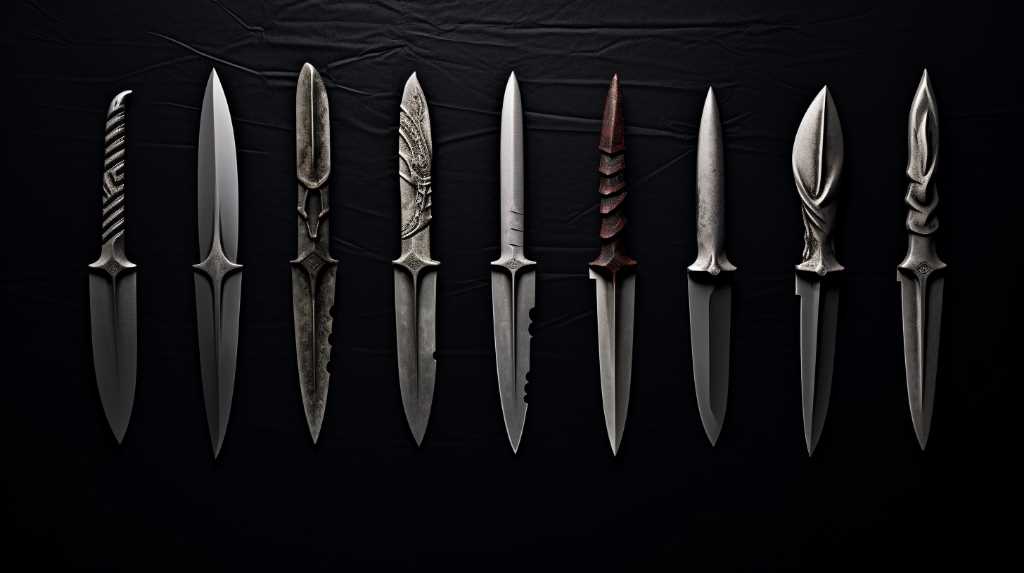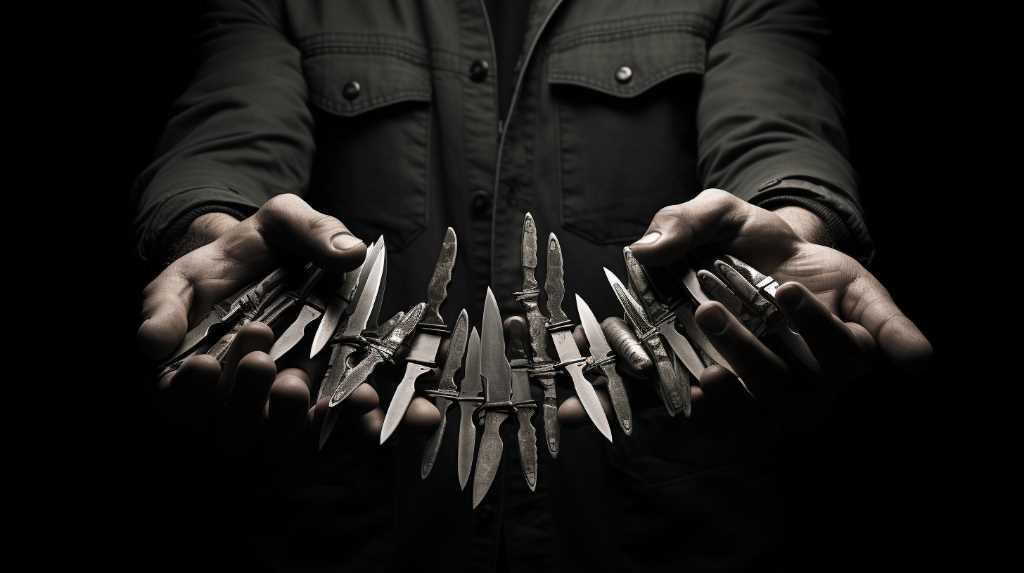
In the pursuit of honing one's throwing knife skills, determining the optimal weight of the blade is a crucial endeavor. Embarking on this quest requires a delicate balance of personal preference, throwing style, experience level, and the willingness to experiment.
This article aims to provide a knowledgeable, precise, and analytical exploration of the factors involved in finding the ideal weight for a throwing knife. By employing euphemistic techniques, we aim to offer an enjoyable and relatable read for those seeking liberation in their pursuit of knife-throwing excellence.
Key Takeaways
- Factors such as strength, technique, intended target, stability, and penetration power should be considered when determining the ideal weight for a throwing knife.
- Personal preference plays a significant role in weight selection, influenced by experience, comfort, throwing style, and the balance between personal preference and practical considerations.
- Matching the throwing style with the appropriate knife weight is essential for optimal accuracy, performance, flight path, rotation, penetration power, precision, confidence, mastery, and control.
- Experience level influences weight choice, impacting trajectory, stability, accuracy, and the balance between weight and control. Gradually increasing weight as skills improve, while subjectivity based on preferences and throwing style. Experimentation and comfort are crucial in finding the ideal weight, leading to improved accuracy, muscle memory, control, confidence boost, and a combination of knowledge, precision, and analytical thinking.
Factors to Consider in Determining the Ideal Weight

When determining the ideal weight for a throwing knife, it is essential to take into account various factors such as the thrower's strength, technique, and intended target.
The weight of a throwing knife affects its stability, accuracy, and penetration power. A knife that is too light may lack the necessary momentum to hit the target with force, while a knife that is too heavy may be difficult to control during the throw.
The thrower's strength plays a crucial role in determining the weight of the knife, as a stronger thrower can handle a heavier knife more effectively.
Additionally, the thrower's technique also influences the ideal weight, as different throwing styles require different weights for optimal performance.
Lastly, considering the intended target is important, as heavier knives may be more suitable for larger or harder targets, while lighter knives may be better for smaller or softer targets.
Personal Preference and Its Role in Weight Selection

While personal preference plays a significant role in weight selection for throwing knives, it is crucial to consider factors such as strength, technique, and target to ensure optimal performance and accuracy.
Personal preference can vary greatly from one individual to another, as it is influenced by factors such as experience, comfort, and throwing style. However, it is important to strike a balance between personal preference and practical considerations.
Strength is a key factor in determining the ideal weight of a throwing knife, as individuals with greater strength may prefer heavier knives for better control and power. Technique also plays a crucial role, as different throwing styles may require knives of varying weights for optimal performance.
Additionally, the intended target should be taken into account, as certain weights may be more effective against specific materials or distances.
Ultimately, the ideal weight for a throwing knife is a personalized choice that should be based on a combination of personal preference, strength, technique, and target considerations.
Matching Throwing Style With Appropriate Knife Weight

Consistently matching one's throwing style with the appropriate knife weight is crucial for achieving optimal accuracy and performance in knife throwing. The weight of a throwing knife affects its flight path, rotation, and penetration power, making it essential to find the perfect balance for individual throwing techniques.
To evoke emotion in the audience, consider the following points:
- Precision: Using a knife that aligns with your throwing style allows you to execute precise throws, hitting the target with accuracy and finesse.
- Confidence: Throwing a knife that feels comfortable in your hand instills confidence, boosting your overall performance and allowing you to push your limits.
- Mastery: By understanding the nuances of different knife weights and matching them to your throwing style, you can achieve a sense of mastery and control over your craft.
Finding the ideal knife weight liberates the thrower, facilitating a seamless connection between their technique and the tool, resulting in enhanced performance and satisfaction.
Experience Level and Its Influence on Weight Choice

Experienced knife throwers should carefully consider their skill level when selecting the optimal weight for their throwing knives. The weight of a throwing knife plays a crucial role in its performance, as it directly affects its trajectory, stability, and accuracy.
For those with advanced skills, a heavier throwing knife can provide the necessary momentum and stability required for longer distances and more complex throws. However, it is important to strike a balance between weight and control. Knife throwers should be able to comfortably handle the weight and maintain a consistent throwing technique.
It is recommended to gradually increase the weight as skills improve, allowing for a progressive challenge and growth. Ultimately, the ideal weight for a throwing knife is subjective and may vary based on individual preferences and throwing style.
Therefore, it is crucial for experienced knife throwers to experiment and find the weight that best suits their skill level and desired liberation in their throwing performance.
The Importance of Experimentation and Comfort in Finding the Ideal Weight

In order to find the ideal weight for a throwing knife, knife throwers must experiment with various weights and ensure they are comfortable with the chosen weight. This process requires a combination of knowledge, precision, and analytical thinking.
Here are three reasons why experimentation and comfort are crucial in determining the ideal weight:
- Improved Accuracy: Finding a comfortable weight allows knife throwers to develop proper technique and consistency, resulting in improved accuracy. When a thrower feels at ease with the weight of the knife, their muscle memory can better adapt to the throwing motion, resulting in more accurate throws.
- Enhanced Control: Experimenting with different weights helps throwers understand how different knives respond to their throwing style. It enables them to gain better control over the knife's trajectory and spin, leading to more controlled and predictable throws.
- Confidence Boost: Being comfortable with the weight of a throwing knife instills confidence in the thrower. This confidence can have a positive impact on their performance, allowing them to focus on their technique and aim without distractions.
Frequently Asked Questions
Can I Use Any Weight of Throwing Knife for Any Throwing Style?
The weight of a throwing knife should be determined based on the throwing style being used. Different styles require different weights to achieve optimal performance and accuracy. It is not recommended to use any weight for any throwing style.
How Does the Length of a Throwing Knife Affect Its Ideal Weight?
The ideal weight of a throwing knife is determined by a variety of factors, including its length. The length of a throwing knife can affect its balance, aerodynamics, and overall throwing performance.
Are There Any Recommended Weight Ranges for Different Experience Levels?
Weight ranges for throwing knives vary depending on experience levels. Beginners may start with lighter knives around 8-12 ounces, while advanced throwers may prefer heavier knives weighing 16-20 ounces. It is important to find a weight that suits your throwing style and skill level.
Can I Determine the Ideal Weight of a Throwing Knife Based Solely on My Personal Preference?
Determining the ideal weight of a throwing knife based solely on personal preference may not be advisable. Factors such as skill level, throwing technique, and intended use should be considered to ensure optimal performance and safety.
Is There a Specific Weight That Is Considered the "Perfect" Weight for a Throwing Knife?
Determining the ideal weight for a throwing knife involves considering various factors such as personal preference, skill level, and intended use. While there is no specific weight considered ‘perfect', it ultimately depends on the individual's throwing technique and comfort.
Conclusion
In conclusion, determining the ideal weight for a throwing knife involves considering various factors such as personal preference, throwing style, experience level, and comfort.
Experimentation is crucial in finding the perfect balance that suits your individual needs. Remember, finding the ideal weight for a throwing knife is not an exact science but rather a process of trial and error.
So, go forth, fellow knife enthusiasts, and may you find the weight that brings you the utmost satisfaction in your throwing endeavors.

